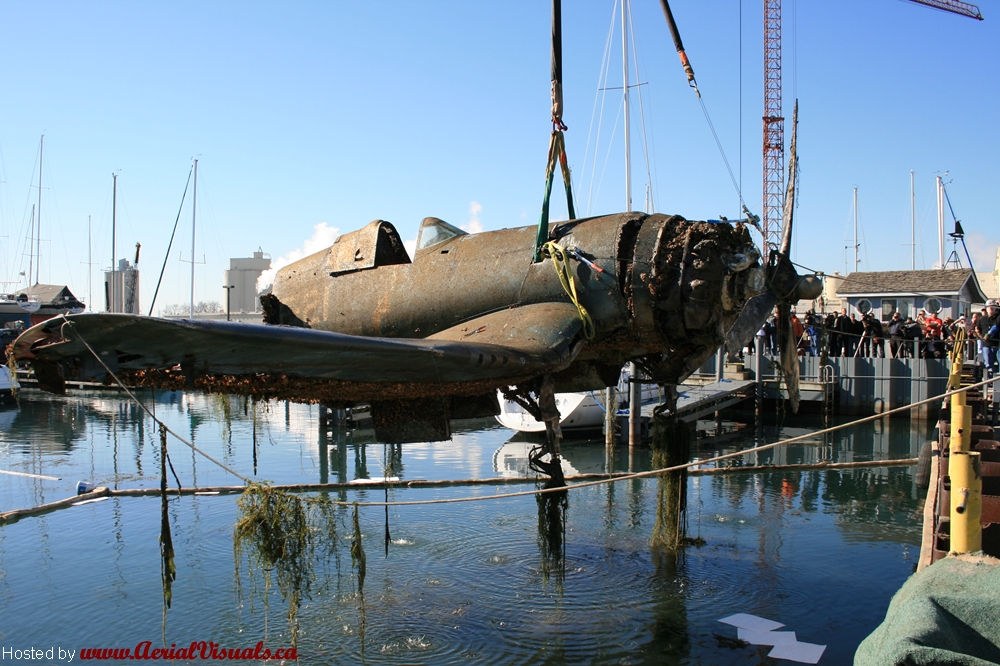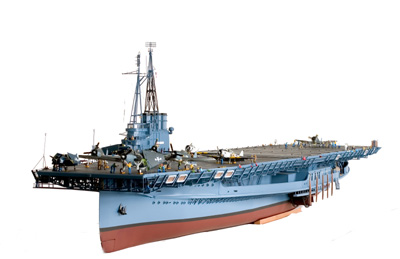
Carl H. Johnson of the United States Naval Reserve was completing his training to land naval aircraft aboard an aircraft carrier in mid June of 1943. Flying in his F4U-1A Corsair, Johnson attempted and failed to land aboard the USS Wolverine aircraft carrier, sending the aircraft and himself into the waters of Lake Michigan.
In the years enclosing World War Two, the United States of America was in a state of total war. The front page of the Daily Mining Gazette on June 12, 1943 contained only subject matter pertaining to the war. Such articles included “Rhineland and Ruhr Hit by Bomb Deluge” to “Allied Headquarters in North Africa”, every resource and civilian hand played a key role in the war effort, from rationing to drafting [9,10]. This means both United States businesses and individuals made several sacrifices for the common good. Such sacrifices included companies like the C and B Transit Company of Chicago, owners of the ship named “SeeandBee”, selling their largest luxury Great Lakes paddle steamer to the Navy for conversion to a training aircraft carrier. The SeeandBee began life on November 6, 1912 as the largest inland lakes steam ship and was used as a luxury cruiser for passengers traveling the Great Lakes. On March 12, 1942 the SeeandBee was sold to the United States Navy [11]. After the addition of a five hundred and fifty foot flight deck as well as other modifications, the steamer became the aircraft carrier USS Wolverine. With the country at total war, the C and B Transit Company of Chicago was not the only one making sacrifices. The United States Navy was sending any dedicated carrier in operation towards the war. This meant that the Navy had to find other means to train new pilots and personnel with aircraft carrier operations. As part of the solution to this issue, training operations began in Lake Michigan namely due to its size, but also because of the security the inland lake had to offer [5]. The USS Wolverine operating out of the Chicago Navy Pier was another part of their solution, however, it was far from an ideal carrier. The Wolverine was considerably small due to the ships original size. One of the problems ensuing from the ship’s size specifically is the deck space.

Shown in the picture to the left is the USS Wolverine’s flight deck with just four airplanes onboard (Corsair, Hellcat, and two Avengers), it is easy to see just how small the flight deck was for operation of an airplane. Towards the bottom of the picture there is a black line, which is important. This is known as an arrestor cable, since the deck of the ship is short, the cable will catch a hook attached to an airplane during landing and slow the craft down ensuring the plane stops before barreling off the ship. On another note, the steam engine and paddle propulsion system, though adequate for civilian use, was not sufficient enough to handle the weight of the ships modifications, resulting in the ships inability to achieve an appropriate top speed. The speed of the ship is crucial, when the ship moves, it creates a wind speed over the deck, this helps greatly when an aircraft is taking off as well as when the aircraft lands.Generally carriers of the day crused at a speed of 33 knots, which created sufficient amounts of wind speed over the deck to allow for normal operation of aircraft [11]. All of these details add up to the fact that the USS Wolverine was far from ideal for the Navy to use for training, however total war left them with little choice. All the problems the carrier had coupled with training being its sole purpose, several accidents occurred.
The Event
One such accident occurred on June 12, 1943 involving Carl Harold Johnson. As stated by Lieutenant J.J. Manly U.S. Navy navigator on June 12, 1943, “1725 F.21 crashed over port beam into water Pilot, Ensign C. H. Johnson recovered by picket boat sustaining only superficial cuts. Plane sunk in 220 FT of water. Marker buoy dropped [8].” Pilot Carl H. Johnson of the Navy Reserve was flying his F4U-1A Vought Corsair in a training exercise just after five in the evening June 12, 1943 off shore of Chicago in Lake Michigan. The exercise was needed to qualify himself to land aboard carriers. The day of June 12 was a well weathered day, USS Wolverine turned into the wind. Luckily the wind was strong enough to help increase wind speed over the carrier’s deck seeing as the steam ship was incapable of the task under its own power [1, 11]. This allowed flight operations to continue as normal. Johnson aligned the Corsair with the deck of the ship and began the landing process. Approaching the rear of the ship, a large wave caused the Wolverine to disappear from Johnson’s line of sight. At this point the crewman aboard the ship signaled for the pilot to begin slowing the airspeed of the plane. As the ship was hidden by the swell, Johnson missed this signal. By the time the Ship came back into view, Carl was past recovering. Despite his attempt to accelerate back to cruising speed and re-approch the landing, the plane was moving just too slow and was too heavy, however, it was still moving much to quickly to make a safe landing aboard the flight deck [1, 2]. With little he could do, Johnson crash landed upon the ship, his plane hit the deck hard and caught the first arrest wire with its tail hook. Johnson’s Corsair over forced the first wire, causing it to break. The tail hook of the Vought Corsair then caught the next arrest wire in line. However, this time instead of the wire breaking, the tail of the plane where the tail hook is located was ripped from the aircraft [1]. With the plane now turned, Johnson and his Corsair careened towards the port side of the carrier. The plane tumbled into the water, floated long enough for Pilot Carl Johnson to escape his harness and then sank two hundred and twenty feet into the water of Lake Michigan [8]. At this point just as Lieutenant J.J. Manly reported, the pilot was recovered by a picket boat and a marker buoy was dropped. Luckily Carl H. Johnson was only minimally injured.
The Pilot
Ensign Carl Harold Johnson was born on March 11, 1918 in Massachusetts where he was raised, he later became a part of the United States Navy Reserve [7]. At the time of the crash on June 12, Carl had almost four hundred flight time hours in the reserve, sixty of which were in a Corsair [1]. After the crash involving his F4U-1A Corsair and the USS Wolverine Carl again attempted to qualify himself and get his “wings” to operate off of an aircraft carrier. This qualification required four flights including four take offs, and four landings aboard an aircraft carrier. June 16, 1943 the qualification was completed in an SNJ 4C leaving Carl Johnson as a naval pilot [1, 3]. From the Carrier USS Wolverine, Johnson was stationed in Hawaii as a Fighting Ten Grim Reaper just as the they received new Grumman F6F-3 Hell Cat fighter planes. On November 25, 1943 flying a F6F-3, Johnson collided with another Hellcat while on a training flight. This resulted in the ejection of pilot Eugene Sumner and death of Carl H. Johnson. Sumner was injured however, survived. Carl was buried in Hawaii [3].
The Plane
Vought F4U-1A “Birdcage”Corsair BU number 02465 was the plane Carl was piloting June 12, 1943. The plane, was delivered March 29, 1943 From New York to the USS Wolverine in Glenview Illinois. Here it would immediately commence in training exercises such as the one Carl Johnson was completing in 1943 [11]. The plane was a very early model F4U, made by Vought, the plane was not prepared for navel use when it was delivered to the Wolverine, nor was it prepared on June 12 when Carl was piloting it [1, 4, 5]. Specific to the Vought F4U’s were the “birdcage” canopies which used metal framing and appeared similar to a bird cage, thus the “Birdcage Corsair” nickname. After the crash on 1943, the plane remained on the bottom of Lake Michigan until 2010. The plane was relocated using sonar in 1995. Recovery of the plane was sponsored by Chuck Geenhill and performed by A. and T. Recovery in Waukegan Harbor on November 8, 2010. Currently the Plane is property of the United States Navy and is undergoing restoration in order to placed on display at the National Aviation Museum [5, 6].
Conclusion
In conclusion, the United States was in a state of total war for the duration of world war two. Everyone in the country had their roll to play and sacrifices to make wether it be the amount of food your family can eat, the amount of steel that can be used, or the quality of training equipment used by the military. Citizens were completely consumed with the war effort, media like news papers and propaganda didn’t stop talking about it. The military sacrificed training and simply made due with what they could. Having every pawn dedicated to the war left them with little to work with when it came time to training. This resulted in inadequate equipment being made from what ever could be found such as a large paddle wheel luxury steamer, or an early unprepared version of an airplane. Several accidents occurred and left to be, sometimes that meant sitting at the bottom of the Great Lakes. In the end the United States won the war no thanks to the inadequate equipment but thanks to the sacrifices and commitments made by the entire county. The Photographs below depict the USS Wolverine (left), and an example of a Vought F4U-1A Corsair (right), for reference.


Secondary Sources
1. Veronico, Nicholas A. (2014). Hidden Warbirds II, Zenith Press. Minneapolis. Print. pp. 44.
2. Cochrane, Jay. (September 20, 2013). “F4U-1 Corsair Recovered From Lake Michigan”. Article.
3. Ellison. Garret. (February 19, 2015). “Secret WW2 Aircraft Carriers on Lake Michigan Focus of History Project”. Article.
4. “Vaught F4U/FG/AU Corsair / F2G Super Corsair” Ariel Visuals Airframe Dassier. Database. Web. 21 Oct. 2015.
5. (November 9, 2010). “WWII plane recovered from Lake Michigan.” General OneFile. Web. 21 Oct. 2015.
6. (November 4, 2010). “Rare Corsair Rescued Early Birdcage Version Recovered From Lake Michigan” EAA Aviation Center. Web. 15 Nov. 2015.
7. Grady. Mary. (November 22, 2010). “Corsair Recovered From Lake“ AVweb. Web 12 Dec. 2015
Primary Sources
8. Lieutenant Manly. J. J. (Saturday, June 12, 1943). “United States Ship USS Wolverine Remarks.” Record of the Bureau of Naval Personnel (Record Group 24) Deck Logs, Declassified 1992. NORA Document. 12 Nov. 2015.
9. Ball D. Edward. (June 12, 1943). “Rhineland and Ruhr Hit by Bomb Deluge”. The Daily Mining Gazette. Article. 12 Nov. 2015.
10. Luce D. Daniel (June 12, 1943). “Allied Headquarters in North Africa”. The Daily Mining Gazette. Article. 12 Nov. 2015.
Further Reading
11. (October 27, 2015) “USS Wolverine (IX-64)” Wikipedia. Web. 15 Nov. 2015
